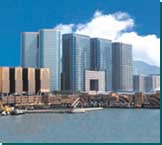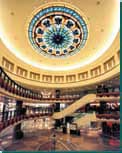| April
2000 |


|
|
|
Gateway II
Making
an Entrance
When height restrictions
were lifted in the early 1990s, Wharf Properties was afforded the
chance to maximise the development potential of its prominent Tsim
Sha Tsui site. The recent completion of the Wong and Ouyang-designed
Gateway II project marks the latest stage in the company's revamp
of the prime property
Following completion of the
first phase -- Gateway I -- in 1994, Wharf set about plans for further
maximising the GFA potential of its 51,657 sq m Harbour City and
Ocean Centre site. Initial plans for the development involved the
creation of office and hotel towers above a new retail complex.
The prospects for office developments were impressive at the time,
as were those for a retail development building on Harbour City's
already-strong image as a premier shopping hub.
As construction
was underway, the client presented the architects with amendments
to the intitial design brief -- in the time since the project began,
the market for serviced apartments had grown alongside mounting
oversupply in the office sector. The development of the second Gateway
phase demonstrated the adaptablity of the Hong Kong property sector
as the towers steadily climbed to 32 storeys each as appropriate
changes were made in the structural designs. Some office floors
were changed to provide hotel and serviced apartment layouts --
office development-style columns are not suited to apartment floorplates,
say the architects. The architects investigated how to change the
structural design from columns to load-bearing walls and where holes
needed to be punched through floor slabs for hotel and serviced
apartment services. Further revisions were called for following
the dip in hotel demand in the SAR during 1998 with the end result
being 499 serviced apartments housed in the upper levels. At all
stages of the development, the architects liaised with the contractor
to implement new design solutions as both headed towards an unchanged
completion date.
 The
exterior The
exterior
The choice of name for the development reflects its significant position;
standing in full view to vessels entering Victoria Harbour. To add
emphasis on this entrance, and to present a bold statement of the
development's location, a distinctive stone-clad curved archway is
set between Towers Three and Five. Aside from its visual significance,
the curvilinear portal houses three floors of column-free office space;
two truss beams fill the equivalent space of a single floor to support
the three levels above. The exterior treatment of the portal shows
four floors, though the lowest level sports false windows to conceal
the truss beam.
The choice of stonework
-- Azalea -- on the portal face relates across the various stages
of Wharf's waterfront project. The original Gateway tower featured
similar stonework of a more reddish colour, as does the new Tower
Six, while the two central towers carry a more pinkish hue. The colour
of stonework is echoed in the portal and, as the architects note,
reflects similar hues chosen by the developer its premier developments
such as Times Square in Causeway Bay. Through this, Gateway I and
its new neighbours can be viewed as a cohesive development, with some
stylistic variation, as well as an integral part of the developer's
portfolio as a whole.
The Gateway curtain
wall comprises either double glazing or reflective glass. Double glazing
had been specified for certain hotel portions of the project which
later reverted to office use. The glazing's placement on the office
floors offers increased energy efficiency benefits to the office tenants.
The tower elevations
draw on design cues established in the initial Gateway 1 project yet
move in new directions with simple and practical design features.
More visible recessing corners, or serrations, unify the new towers
while each tower features curvilinear elevations. The development
stands 300 metres in length and as such risked becoming a single,
straight facade or a wall pressed against the waterfront. The curved
elevations break this visual impact and clearly present the individual
building forms to viewers. At roof level, the presentation is flat;
on the level set by the first towers. The architects note that as
the majority of projects in the Tsim Sha Tsui area use flat roofs,
the rooftop treatment fits into the local built environment. Despite
restriction at the site dictating the height of Gateway I and the
subsequent towers, a maximum number of floors has been incorporated
into the development. A post-tensioned flat-slab flooring system,
with drop panels around column heads to take up loads, is used to
ensure clearances for ceiling E&M services. Further services are
routed through floor trunking and conduits.
Courtyard entries
The main entrances to the mall and the development above are placed
between the existing buildings lining the harbour side of Canton
Road. Pedestrians enter through courtyards signposted by festive,
brightly-coloured cladding at the streetfront. Facades lining the
courtyards are upgraded in the pinkish hues of the towers' stone
finishes, applied here as stonework and spray coating. Eateries
are on hand to add a more refreshing ambience. On the ground is
a mosaic of granite tiles, arranged in marine-inspired patterns
to denote the identity of Harbour City. According to the architects,
the entries serve as quiet buffers from the busy western Tsim Sha
Tsui streetscape.
Pedestrians travel
up a flight of steps out of each courtyard and into the mall. Entrances
to the offices, via escalators, are aligned with the courtyard entry
points to give as straight a line of travel as possible. The escalators
lead up to the third floor lobbies designated for the towers --
the mixed uses of the development are segregated accordingly. Separate
entrances are provided for the serviced apartments while office
floor elevators will not stop on the serviced apartment floors and
vice versa.
The shopping street
The Harbour City shopping mall has, over the course of its existence,
served as a de facto covered walkway stretching along Canton Road.
The architects noted that pedestrians entering the mall at the Peking
and Haiphong Road junctions, previously chose the air-conditioned
route through the mall's tight and winding corridors along to Ocean
Terminal and the Star Ferry Piers. The redevelopment provided an
opportunity to build on, and improve, this circulation. The straightforward
solution is that the new first and second floor retail areas are
arranged in a straight line -- the pedestrians' lines of sight cover
the length of the development. Lofty atriums are installed as punctuation
along the mall's length. With the help of the open spaces, arriving
visitors can immediately identify their location within the mall
before heading off to their destinations. The arrangement has proven
successful, say the architects, and the end result has been the
formation of a new shopping street for the Tsim Sha Tsui area.
Ceiling heights
within the retail area were dictated by the clearances in the existing
retail areas to which it is joined. The possibility of raising the
ceiling height in the new mall proved unfeasible -- the necessary
stairs and ramps to accomodate the floor level diferences would
have been a less-than-favourable arrangement for shoppers. Despite
the headroom being slightly lower relative to other retail developments
in the SAR, a sensation of space and headroom is provided with the
placement of atria with vertical transport placed within.
Construction challenges
Development of Gateway II called for the demolition of three residential
blocks and the portion of shopping mall beneath, creating multiple
challenges in the project's realisation. The podium and basement
structures were structurally connected, posing challenges in not
disturbing the remaining mall and buildings during the demolition
process and the subsequent interfacing with these structures as
the new project went up.
The Harbour City
complex was relying on a central building services system -- in
particular the ventilation system as well as the electricity supply.
The architects, contractor and consultants liaised to ensure sufficient
services were uninterupted as the contract proceeded. A services
diversion ensured that the sea water pump house for the water-cooled
air-conditioning system remained connected to the buildings on the
opposite side of the site. This was another project in itself, say
the architects.
Demolition of the
existing buildings posed the difficulty of countering the uplifting
effect as the dismantled structures became lighter and lighter.
The solution was appropriate backfilling of the basement with demolition
debris to ensure a constant loading to overcome the uplift. Interfacing
the new and existing basement was similarly challenging in adhering
to fire safety regulations and supressing water pressure against
the site. Where the two basement structures would break through,
a temporary wall and fire shutters were installed. Emergency exit
stairs and escape routes were also designed for the vertical discharge
needs of surrounding blocks and hotels during the construction period.
Traffic concerns
One condition of development for Gateway II was implementing traffic
control measures. With the completed project bound to increase the
number of vehicles coming into the Canton Road area and surrounding
streets, the waterfront strip in front of the development was earmarked
for traffic. Incoming traffic to Gateway II and Ocean Terminal is
directed along the harbourside. A new circular ramp acts as an exit
from the Ocean Terminal carpark to reduce the traffic load at Canton
Road. In the time since Gateway II's completion in late 1999, the
arrangement, combined with a nearby flyover, has proved a success
in alleviating the traffic jams that once plagued the area.
¡@
| FAST
FACTS |
- Total GFA ...........................................
- Building height
......................................
- Demolition ...........................................
- Completion ..........................................
|
242,156
sq m
128.9 mpd
January 1994
October 1999 |
developer Wharf Properties
Ltd
architect Wong & Ouyang (HK) Ltd
consulting
engineers Wong & Ouyang (Civil-Structural Engineering) Ltd
Wong & Ouyang (Building Services) Ltd
main
contractor Chevalier Construction (HK) Ltd
|
 The
exterior
The
exterior